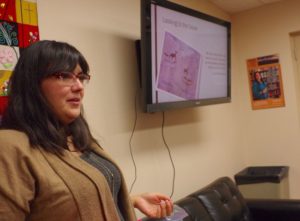Lakehead University Master of Education student shares lessons from land and water

By Rick Garrick
THUNDER BAY—Pic Mobert’s Melissa Twance enjoyed sharing her thesis research on Lessons from Land and Water: Indigenous Connections to the Mazinaabikiniganan of Agawa Rock with students at Lakehead University’s Aboriginal Student Lounge, on Feb. 16.
“A lot of them are doing research courses in Indigenous Learning or they are doing their honours thesis themselves,” says the Master of Education with an Indigenous Specialization student following her presentation. “As a master’s student, there’s not a lot of us Indigenous people in grad studies, so having somebody come in and talk to them kind of about the process and how it all works, I think that is helpful.”
Twance developed two research questions for her thesis: how are Mazinaabikiniganan (pictographs) valued in Indigenous communities today and how can they and the knowledge they embody act as a form of critical land-based education.
She travelled to Batchewana First Nation and recruited six community members to help with her research on the pictographs at Agawa Rock, located in the community’s traditional territory in Lake Superior Provincial Park, about 90 minutes north of Sault Ste. Marie.
“I used a lot of story work and conversation,” Twance says. “Rather than using semi-structured interview questions and sitting down and being like, ‘So tell me about this,’ and asking them really pointed questions, I kind of left it wide open so they could tell me stories about whatever it was they wanted or whatever they felt was important. So that way the data wasn’t limited by a narrow scope of questions.”
Twance says the community members told her stories about fishing, court cases that were going on, and conflicts with the provincial government. Although she found the stories to be a “little overwhelming”, Twance eventually found some common themes among them.
“Number one, our territories hold our histories,” Twance says, noting that the community members pointed out landmarks in the area to her. “And each of those places had a story attached to them. A lot of those stories had to do with people and their families, like ‘my grandfather used to mine copper up on this hill’ or ‘my uncle used to have his fishing tug sail out of this harbour’.”
Twance says the next three themes were that water is considered to be as much a piece of the community’s territory as the land; the idea that the community has resisted settler colonialism; and the idea that spirits occupy place.
“When they were telling these stories about the land, they were able to point to a place and [say] there’s spirits that live there or [it] is a ceremonial place or ‘my grandfather used to tell me a story about this woman that lived out there and you can see her face in the rock’,” Twance says. “It shows that the land isn’t big and empty — it’s actually populated by…others [aside from] human beings, including animals, plants, spirits and things like that, that were put in place to help us.”
Twance says the landmarks and the pictographs were put there to remind the Anishinabe that they have roles and responsibilities.
“We have obligations to maintain our connections with spirits, we have obligations to stand up and continue to be Anishinabe people, we have an obligation to our territories to look after them and maintain them to make sure they are there for future generations,” Twance says. “And we also have obligations to hold onto those histories and pass them down.”


